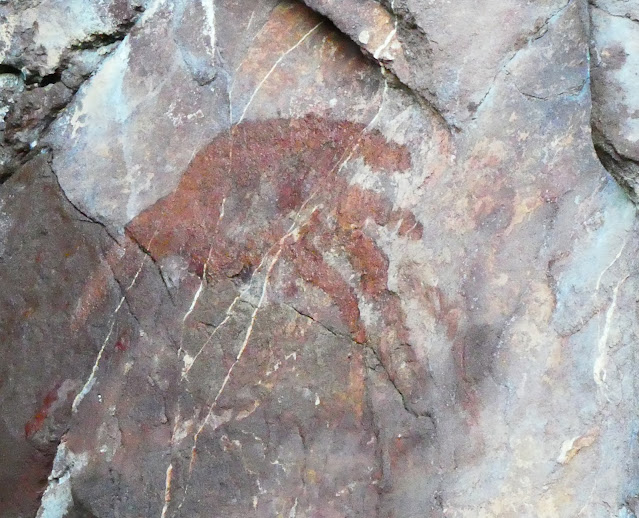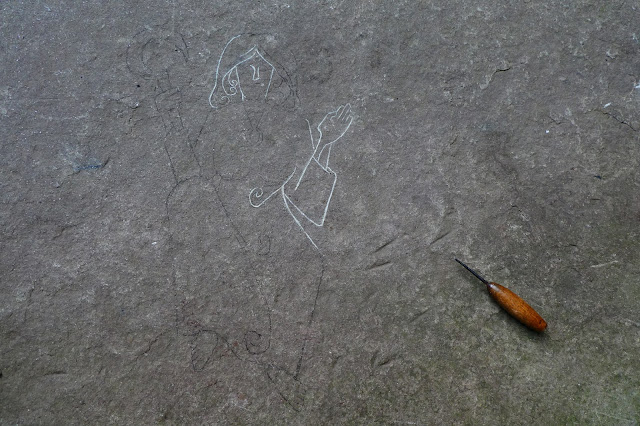Reflections Upon the Ylfish and Ulfish Cultures
The Ylfu – the ‘elves’ of my world – whilst ensconced in their mighty subterranean barrow beneath their ancient city Dofran (the OE name for Dover, complete with ‘steadfast white sea-walls’), are more precisely informed by Welsh culture, especially the bardic tradition, which underlines the poetry recited in the court of Yldfreah (the name which our narrator gives to the Ylf-lord – his name literally ‘Old lord’, which is more of a title really – cf. the Old Norse fertility god, Freyr, and probably one given to him by the narrator as a reference to his own linguistic culture).
Hence the very Welsh-derived lament which the Ylfish bard Meloth sings in honour of the leader of Gifli’s expedition:
'The Song of Haeleth of the Dawn’s-Light'
‘Seven we were, and seven we fell,
seven in strength, by honour bound
now none but names, now none remain,
to light the lands of multitudes.
For while we stood, we held our ground
and seven by seven foes in rage
could not bear battle at our shields;
they fell to us, we fearless few.
But then, when Haeleth fell, we lost
not one of us but all of us;
lost all our light, our heavens’ shine,
what worth we have should we yet live?
A spear it was brought day to dusk,
in shadow threw us, we who stayed;
she was unflinching, the faultless one,
when gored by ash-wood, dropped her shield.
The blood streamed forth like sun’s rays,
pierced in the neck, her cries went forth
though once the purest tones of songcraft,
then darkened to a raven’s croak.
Since Haeleth fell, she who led us,
to the field, gave grief to many;
now Lēoma’s hall is brighter,
and we are lost, in darkness cast,
this song all that of us remains;
the sons of I’uddiff, on shores of fate.’”
a piece originally inspired by and modelled on the 12th Century Killing of Hywel ab Owein, the most relevant lines being as follows:
While we were seven, thrice seven dared not attack us, nor made us retreat while we lived; alas, there are now but three of the seven, men unflinching in fight...Since Hywel is gone, who bore battle gladly, by whom we used to stand, we are all avowedly lost...with a spear...Hywell the Tall, the hawk of war, was pierced. (Peryf ap Cedifor, from A Celtic Miscellany, transl. Kenneth Hurlstone Jackson, Penguin, 1973).
The Amazonian Ylfish swordswoman Gwearyffeth, vengeful sister to Haeleth of the Dawn’s-Light, bears the epithet ‘Hawk of Thrimilci’ - Thrimilci being the Ylfish name for the month of May (derived from the OE Đrimeolce, thus rendering Gwearyffeth an analogue to the Arthurian Gawain – who in certain traditions may be derived from the Welsh Gwalchmai, or ‘Hawk of May’. Brian Stone (in his translation of Gawain & the Green Knight, Penguin 1968) reminds us, following Robert Graves’ The White Goddess that the hawk “is of course a sun-bird” - and as Gwearyffeth’s ultimate destiny, she believes, is to destroy Fyrfax, the slayer of the beloved sun-queen Lēoma, she also represents the reborn sun-goddess-in-waiting. Like Gawain and his prototype Cuchulain, her strength grows with the rising of the sun:
“The ‘Hawk of Thrimilci’, so she is known;
early summer’s keen-eyed daughter;
mightiest at mid-day, the blade-strong maid...”
a detail which in fact accounts for the onset of the battle at dusk, and its climax occurring the following afternoon, when multiple paths of destiny intertwine – or end.
Therefore, a deliberate cross-gendering of solar warrior/king→ solar warrioress/queen, endows the Ylfu with a Celtic character, an association fairly universal in British elf-legends of a certain era and further helps to contrast them completely with the patriarchal (and lunar) Ulfhednar. In this way, the Ylflands embody the purely solar end of the spectrum – the Ulfish nation the lunar opposite – and Gyldland rests in the middle. Both Gyldish and Ylfish cultures set the sun-goddess (with very different character, attributes and names) as their prime deity, though Ylfish culture venerates their goddess to the point of monotheism (any similarities to the solar cycle elements of Christ’s death and resurrection are, actually, coincidental – perhaps reflective of the universality of such themes in world mysticism). In the narrative and its dialogues, the Gyldish sun-queen Gydena is usually abstracted as Sóli, the living sun herself, and other gods – Hrefni, the storm-father and Smorian, the queen of the dead (who is not even a first-generation deity but Hretha and Mægtha’s daughter) are named and invoked far more often, as befits a narrative where storm, strife and death are writ large. Other nations and peoples do exist – such as Myrkahof, the land of the Dvargar; also the land of the Orknoís, pig-folk of distant realms (semantically related to the orcneas of Beowulf, the Orkney Islands and the Irish proper name Noíse, → ‘orcs’); see Graves (The White Goddess) on the underworld associations accorded to the hog, and the naming of the Orkneys thus, but details on these lands are sketchy.
Prior to the climactic battle, the Ulfish female druids chant a grim ritual song:
“War-knots cast, slaughter-spears slung,
blood charms chanted, glory-wyrd wrought.
The gore of slave-born greatly runs
to the roots of Victory-ash in splendour;
give to us our rightful dues,
a feast of carnage in the field.”
The charm represents the verbal component of a sacrificial process whose somatic aspect is, clearly, the killing of slaves (most likely human, to judge from previous occurrences – the first, explicitly enacted at the request of the landwihtan in Chapter XXIV; the second described briefly by Smeoru-snettru in his account of the siege of Gold-heart to Womba in Chapter XL, where he says
“The Ulfhednar, the slaughter-keen,
slew many slaves before the siege –
an act of blood-devotion, so I’m told.
Perhaps the gory deed was good;
we won the day, with bow and blade...”
The striking contrast between the Ylfish and Ulfish cultures is also underscored by a small but almost very significant incident, again, prior to the final battle, in which an Ylfish character carries a dead wren on a stick, a ritual derived from the real-world ‘ death of the sun’ mythical motif. In Ylfish culture the wren represents darkness, the antithesis of Leoma, and as a result is hunted and hung with reverence to the sun-queen, in a rather barbaric and primitive application of Frazerian sympathetic magic (kill the dark-associated animal to kill the dark itself – see any edition of The Golden Bough for more examples than any researcher could ever need). However, one of the Ulfish druidesses sees this and almost sparks a full-scale revolt as a result, for the wren is contrarily sacred to them, specifically because of its dark and sinister associations (I’m indebted to the entry in Stuart Gordon’s Encyclopaedia of Myths and Legends for these details, including a note on the wren having fulfilled a Promethean role in French legend, by snatching fire from heaven, and its sacred status to Taliesin). In this way is the very fine balance of tolerance and intolerance between three completely disparate cultures (the Gyldish humans, the Ylfu and the Ulfish) revealed. I also liked the idea of the giant, ferocious Ulfish people holding dear not a mighty soaring eagle or flesh-tearing raven, but the smallest of birds, showing that associations and mythical symbolism need not be of the most obvious kind. Due to its cave-dwelling habits, the wren may have been identified by the very early Ulfish people when they first settled in what would become Hulthrenaark, the land of the eternal moon, as a fellow dark-dweller, and the fundamental association thereafter developed by the druid class who, despite being exclusively female in an otherwise warrior-based patriarchy, still perform essential duties of ritual, sacrifice and – assuming their druidic nature is similar enough to the Celtic reality – possess vital knowledge of the movement of the heavens (stars, we’d suspect) in order to fix significant dates, devise calendars and therefore control many of the basic regulatory functions of life: when to sow, when to harvest, and of course what counts as auspicious (or inauspicious) times for certain activities such as raiding, trading or feasting.
Note: Whilst on the subject of months and seasons, I'll append these ideas regarding the 'standard' (Gyldland) calendar for reference:
Yule-eve (January)
Ash-M’noth (February)
(Rhed-M’noth) (March)
(Eostromonth) (April)
Thrimilci (May)
Solmonath (June)
Lida (July)
Woedmonath (August)
Halegmonath (September)
Winterfylleth (October)
Blotmonath (November)
Yule-morn (December)
This list of months is based on that compiled by Bede in about 725, and in which the year began with December. Yule is derived from Giuli. I'm not sure if Yule-eve and Yule-morn are the right way round - it depends upon whether the Gyldland system of time starts the day with dawn, or dusk. Given that the whole story begins at midwinter, and the giving of blót to the gods as was historically the case, I suspect that the new year actually begins with the close of the Solstice.
Having no sun and therefore no daytime, the Ulfish count in months, and measure greater time from notable events – although they also ‘collect’ months into groups of 13 (lunar years) which are used to measure such gaps. These aren’t viewed as years as such, as the Ulfish know little agriculture – so seasons are of less importance (being primarily hunters and cattle farmers), with seafood/fishing also a huge commerce, which sustains the thralls, while lords and their retinues alone have the right to hunt the beasts of land and air – historically, ice-ox, ice-elk, birds etc. Certain plants do grow, and forests of stark iron-wood flourish, which sustains the animals.
Note: the difficulties of lunar calendars in reality for locations north of the Arctic Circle are described by E.G Richards in Mapping Time (Oxford, OUP, 1998) in his section on the Icelandic calendar, wherein the "moon is frequently not visible for days on end".


Comments
Post a Comment